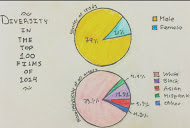Diversity in film and literature

With the recent boxbuster Star Wars: The Force Awakens taking cinemas by storm, complaints about John Boyega have arisen. A minor backlash over his skin color has taken place on social media, with some people who claim to be avid fans of the franchise saying a black stormtrooper is unrealistic.
“I’m in the movie, what are you going to do about it? You either enjoy it or you don’t. I’m not saying get used to the future, but what is already happening. People of color and women are increasingly being shown on-screen. For things to be whitewashed just doesn’t make sense. All the films I’ve done have had a secret commentary on stereotypical mentalities. It’s about getting people to drop a prejudiced state of mind and realize, Oh [expletive], we’re just watching normal people,” Boyega said in response to this.
Recent outrage over the demographic of the Oscars has generated the hashtag #OscarsSoWhite, which is being used extensively on social media sites such as Twitter and Facebook. Last week’s nominations, which was entirely all white, is what incited this negative attention, though this has been a notable problem since the first Academy Award show in 1928. Only 6.7% of all the 1,668 nominations in the entire history of the Oscars has gone to people of color.
Things like the Bechdel test provide a set of criteria in film and literature by basing whether there are at least two female characters talk to each other about something other than a man. In 2013, the LGBTQIA supporting organization GLAAD coined the “Vito Russo test”, which includes the following criteria for film:
It must contain a character that identifies as lesbian, gay, bi, and/or transgender
The character is not to be solely defined by the sexuality or gender identity. They must be important enough to the plot that they would have an impact on the overall movie if they were to be removed.
Many children’s books are also under fire, especially the older ones that support gender-based or racial stereotypies and are still a major part of many Americans’ childhoods. Classic stories like the Brothers Grimm’s and older Disney films often push these images of women as unable to fend for themselves, or either need the man to save them or that the man will be what makes them happy.
Thanks to campaigns such as We Need Diverse Books and the recent children’s films like The Princess and the Frog and Big Hero Six (which has a cast with female, black, hispanic, and Asian representation), there is an evident change in the sort of media today’s children are seeing when compared to what this generation of adults and the elderly grew up on.
